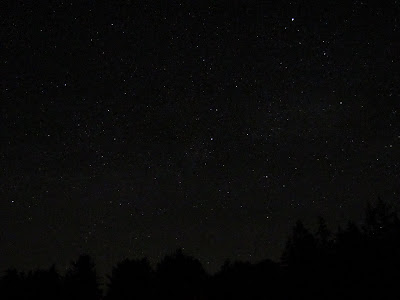 |
| Explore Scientific refractor on Meade LX80 mount |
Though stated in previous posts, I cannot emphasize the necessity for dark skies enough. Light pollution and ambient light are the astronomer's worst enemy, next to unfavorable weather conditions. Of all the observing sites in Pennsylvania, amateur astronomers will suggest packing a telescope, and camping gear, for a night or two at Cherry Springs State Park--the darkest site in the state. It is at this mountain-top location where light pollution and ambient light are absent, providing freshmen and veteran astronomers with an "open window" for deep-space objects, such as galaxies, globular clusters, nebulae, etc.
Three weeks ago, my dad and I attended the Cherry Springs Star Party, an event held every late spring/early summer--refer to my previous post for more information about star parties. For our nighttime observing, we brought along an Explore Scientific refractor, and for solar observations a Lunt solar scope.
 |
| Same scope, different angle, and in monochrome |
Observing through telescopes easily satisfies the amateur astronomer, although there are some who prefer alternatives. One popular alternative to observing through telescopes is capturing the night skies with cameras. You think photography is restricted for daytime pleasure? Think again--astronomers can capture images of the night sky with cameras. However, for astrophotography, the astronomer must use a camera that can be manipulated; in other words, the shutter speed, ISO, and focal length are altered. Cellphones, pocket-sized cameras, basic cameras in general cannot be manipulated easily. Personally, I recommend the Canon SX20 IS, as a starter.
Although the camera lens is permanently attached to the Canon SX20 IS, one can alter the shutter speed, ISO, focal length, color, and more when operating under manual settings. By default, the camera is set with automatic settings. Using manual settings, I experimented with my SX20 IS at the Cherry Springs star party, taking 15 second exposures with an ISO of 1600 and 2.8 F-stop. I took numerous photographs of Cygnus (or as I called it "The Australian Boomerang"), Cassiopeia (the big 'W'), and Scorpius. I've captured these constellations, as well as Ursa Major and Minor, and, much to surprise my dad and I, three nebulae near Scorpius. 15 second exposures are barely adequate for capturing deep space objects, yet my camera captured three nebulae; they appeared as small fuzzballs. To properly capture deep space objects, exposures must last 30 seconds or longer, an operation my camera couldn't accommodate without altering the operating software.
From my brief experiments in astrophotography, using the SX20 IS camera, not only have I rediscovered my interest in photography, I've also gained an interest in astrophotography. My interest in both fields have lead to the recent camera upgrade, from the SX20 IS to the T3i. With the new camera, my intentions are to take serious astrophotography photos, with and without the aid of telescopes.
The following images are only a few of the photographs taken at the Cherry Springs Star Party. Due to these photographs being part of an experiment, I've hand-picked a few to display.

Cygnus and Cassiopeia
Notice the faint straight line of dots to the right of Cassiopeia--it is a passing satellite
Should the weather be favorable this weekend, my dad and I may take another trip to Cherry Springs. Since the upgrade to the Canon T3i, we've been eager to take astrophotography images with it. Until next time, be on the lookout for Cherry Springs State Park--Park 4.







